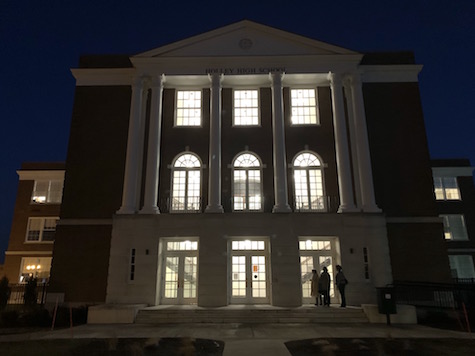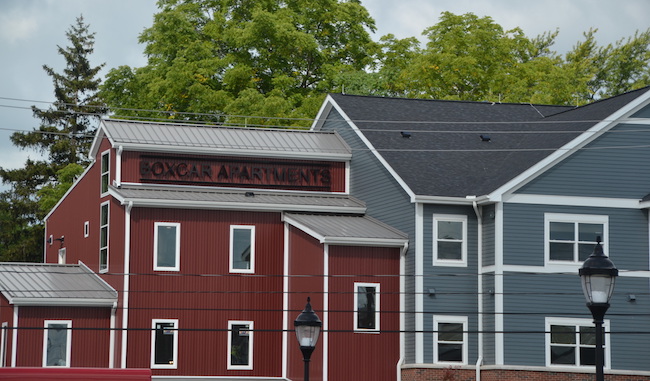Housing study for Orleans says need for smaller houses and lots, townhouses
New housing construction has slowed in county in past 15 years

Photo by Tom Rivers: The former Holley High School opened last year with 42 apartments, which were quickly filled. A report about housing in Orleans County said more townhouses, smaller single-family homes needed in the county.
ALBION – A report about housing in Orleans County advises local officials to consider some zoning changes to allow for single-family housing on smaller lot sizes, and also encourage more high-density development, such as townhouses and condominiums.
The report, presented to the Orleans County Legislature last week by LaBella, said the county has an aging housing stock and about half of the houses need repairs.
The median household income in the county also makes it difficult for landlords to charge enough rent, making for a low return on investment.
Building permits for housing are about a third of what they were 15 years ago. The redevelopment of the former Holley High School, which added 42 apartment units last year, is an exception. Those units were quickly rented out and show there is demand for high-density living in the county.
The county paid LaBella $5,000 for the study. County Legislator Ken DeRoller of Kendall advocated for the study after seeing local building permits plummet in recent years and the population steadily decline. DeRoller said that may be a reflection that the existing housing and zoning are not in sync with housing development.
He is suggesting local officials look to set aside some land for housing that may currently be farmland. That is a discussion that should be taken up among farmers, the county’s Farmland Protection Board and local officials. If the zoning was changed to allow smaller lots, DeRoller said there would be affordable new housing opportunities with only a small impact to productive farmland.
There are also opportunities for new construction with vacant lots in villages. DeRoller also sees the Erie Canal as an attractive waterfront option with the right zoning in place.
Key findings in the report include:
• Single-family, owner-occupied units dominate the market: About 50 percent of housing stock throughout the county is comprised of single-family homes on large lots. Future projections show a need for smaller homes on smaller lot sizes, which would also drive down the costs for a new house.
• Almost 50 percent of renter households have housing problems and cannot afford market rents: The report states that 49 percent of renters are living in units that are not affordable. Housing Choice vouchers available in the county address some of the affordability issues, but only a small fraction of the need. The report also says 51 percent of renters have housing problems such as incomplete kitchens or bathrooms and more than one person per bedroom.
• More than 50 percent of housing stock is 60 years or older: Housing maintenance is therefore a major priority in the county, Labella stated in the report.
• Renters and homeowners both have housing problems: The number of homeowners with housing problems (3,010, according to the report) exceeds the number of renters (2,010) with housing problems.
• Return on investment is low for owners and rental developers: Rental rates in inflation adjusted dollars have decreased over the last 20 years, and home values, in inflation adjusted dollars, are also down in the 20 years. (This doesn’t include the recent spike in the past year with many homes selling for 20 to 25 percent above assessed value.) The lack of growth in rental rates and home values discourages upgrades and maintenance of homes, as well as new developments.
• Population decreasing: Orleans County’s population is down 5.9 percent from 2010 to 2020 or by 2,540 people, from 42,883 to 40,343. From 2000, the decline is 8.7 percent when the population was 44,171. “Finding ways to attract new residents would increase the demand for housing,” the report states.
• Population getting older: The average age of residents in Orleans County increased from 36.2 in 2000 to 43.0 in 2019.
• Shrinking household sizes: The size of the average household shrunk from 2.65 in 2000 to 2.28 in 2019.
• The report also finds a need for more housing units for extremely low-income households, and there is also demand for higher-priced apartments.

DePaul is close to completing a new 40-unit housing project in Albion on Liberty Street. The property is known as the Boxcar Apartments is located between the railroad tracks and Beaver Street. The complex will have 36 one-bedroom units and four two-bedroom units.
Housing Characteristics
- The report finds that the large majority of housing units are currently owner occupied, with 76 percent owner occupied compared to 24 percent that are renter-occupied.
- Of the occupied housing units in the county, 75 percent are single-family homes, with 11 percent mobile homes, 9 percent that are multi-unit and 5 percent that are two-family.
- New construction of housing units has generally been trending downward. There were 70 building permits for housing in 2004 and that dropped to 24 in 2017 and 23 in 2018 in Orleans County. There was an anomaly in 2019 with 65 permits for housing units, with 42 at the Holley gardens, the former Holley High School that was turned into apartments. Without the school project, there were 23 building permits for housing units in the county in 2019.
- Age of housing stock in Orleans County: The reports shows 57 percent of housing units in the county were built before 1960 and only 6 percent were constructed in last two decades. A breakdown shows 44 percent built from 1939 or earlier, 13 percent from 1940 to 1959; 20 percent from 1960 to 1979; 18 percent from 1980 to 1999; and 6 percent were built in 2000 or later. The report says any housing programs in the county “must” include a component to rehab older homes. Some of those older housing units may need to be demolished.
- Median housing values: Using inflation adjusted values, median housing values in the county have slightly decreased from $105,874 in 2000, $100,366 in 2010 to $98,400 in 2019.
- Median gross rent has also fallen. Using inflation adjusted values, the gross rent for Orleans County rentals has dropped from $774 in 2000 to $732 in 2010 to $728 in 2019.
- Affordability: The report says nearly half of renters, 47 percent, are living in housing that is unaffordable and over 18 percent of renters are spending more than 50 percent of their income on housing. Three out of four homeowners are living in housing that is affordable. Some subsidies are needed to help lower-income people have affordable housing.
- Housing problems: Overall, 31 percent of households report a housing problem, which could include basic needs like a complete kitchen and bathroom facilities. The report said programs for housing rehab are needed but some of the houses are so unsafe and dilapidated it doesn’t make sense to rehab them and they should be torn down.
Demographic Characteristics
- Population loss: Orleans County’s population is down 8.7 percent from 2000 to 2020, according to the report which cited census data. That is a decline of 3,828 people over 20 years. The population in Orleans was 40,343 in 2020, down from 42,883 in 2010 and 44,171 in 2000.
- The decline on household sizes could result in less demand for the larger single-family houses in the future, according to the report.
- Medina age: The county’s median age has changed significantly from 36.2 in 2000 to 43.0 in 2019, likely due to stagnant population growth, lack of young families and people moving out of county. During that same period, the median age in the state went from 36 to 39 years old, and nationally it went up from 35 to 38.5. Based on current trends and projections, nearly 60 percent of the Orleans County population will be 45 or older by 2040.


































































